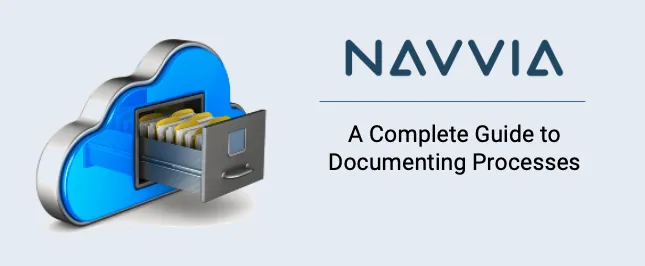Process Documentation: A Complete Guide
Blog: Navvia Blog
Documenting processes may not be the most exciting activity, but process documentation is essential to any organization looking to streamline operations and improve productivity.
In this article, we will cover:
- Why do we document processes
- How to document a process
- Process documentation template
- Process documentation tools
Why do we document processes?
There are three fundamental reasons why you should document your processes.
- Communicate the “as is” business process
- As a starting point for process improvement
- As a blueprint for process automation
“As is” Process
An “As Is” process is just another way of saying your current process.
If you want your organization to achieve its goals, you need all employees pulling in the same direction.
Having comprehensive process documentation is a way to get everyone on the same page.
Process documentation acts as a job-aid for existing employees, a training guide for new employees, and a reference point for process governance and oversight.
Process Improvement
Continuous Process Improvement is essential in removing the inefficiencies and waste in your processes, improving employees’ productivity, and aligning your processes to new business objectives.
Learn how a SIPOC diagram can help drive Process Improvement
Digital Transformation is also one of the highest priorities for many organizations. It is a way of improving business operations through the application of digital technologies.
Process Improvement or Digital Transformation in an organization is very difficult unless you have a clear understanding of your “As Is” processes (what you are doing today) and your “To Be” processes (where you plan to go).
Learn more on how Business Process Management drives Digital Transformation.
Process Automation
I like to say that “a well-documented process is a blueprint for process automation.”
Let me put it this way; would you build a skyscraper without a set of blueprints? Then how can you automate a process unless it’s been clearly defined?
A well-documented process includes all the data and tool requirements needed to drive automation.
The process documentation becomes the “user story” that guides developers in automating the process while establishing the acceptance criteria by which the business can validate a successful implementation.
Having well-documented processes and comprehensive technical requirements will accelerate Digital Transformation by minimizing waste and re-work. A lack of process documentation and technical requirements is one of the key reasons Why Digital Transformations Fail.
Learn more about driving better requirements through DevOps in this recorded webinar.
How to document a process
Comprehensive process documentation ensures you have captured the complete end-to-end process, including; inputs, outputs, activities, tasks, roles, responsibilities, procedures, governance, data, and tools.
It is impossible to document a process by yourself.
You need to bring together a subset of knowledgeable stakeholders that understand how the process works today.
A substantial amount of work in an organization goes undocumented, residing only inside people’s heads.
One of the best ways to capture a process is through interactive workshops.
You can capture process details in realtime using tools such as the Navvia Process Designer.
Want to learn more about documenting processes? Check out our Introduction to Process Mapping article.
Process documentation template
There is much more to a process document than a simple flowchart. Yes, a flowchart is an important part, but it doesn’t tell the whole story.
Comprehensive process documentation needs to tell a complete story. It’s the end-to-end narrative that captures all the essential elements of the process.
It also should be modular so that you can repurpose it for different audiences (without having to re-write the whole thing). What do I mean by that?
Each section should stand on its own, for use in other related documents, such as:
- An Executive Summary
- As a job-aid for the users of the process
- An onboarding document for new employees
- A reference guide for auditors, aid for process
- User stories for process automation specialists
Here is the table of contents from an ITIL-based Change Management process. I’ve provided two views, one for a Complete Process Document and an Executive Summary.
Want to see a bit more detail? Download this sample process documentation for an ITIL-based Access Management process.
Did you know that the Navvia Process Designer can automatically create tailored process guides for you? Click here to learn more.
Process documentation tools
There are a variety of tools for process documentation.
When first designing a process flow, many like to use a whiteboard and yellow stickies.
When documenting a process, many folks turn to Microsoft Visio and Word products.
Some organizations use complicated and expensive BPMN tools.
The problem with these tools is that they are either labor-intensive or overly complex to learn and use.
We recommend you take a look at the cloud-based Navvia Process Designer.
Navvia is an inexpensive yet powerful tool to design, document, and share your processes. With Navvia, you can:
- Perform process maturity assessments
- Design and document processes
- Capture technical requirements for automation
- Automatically generate process documentation
- Perform process governance
- Get started with ITIL, Servicenow, and COBIT templates
Register for a live 30-minute demo
The post Process Documentation: A Complete Guide appeared first on Navvia.
